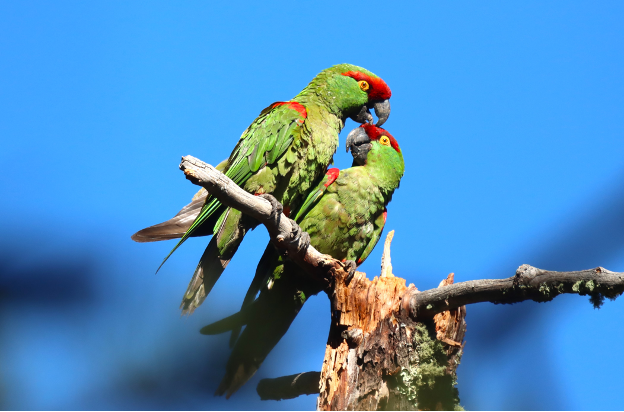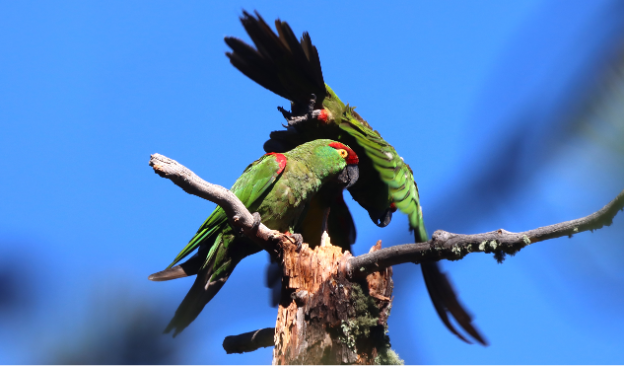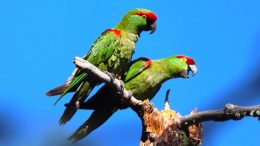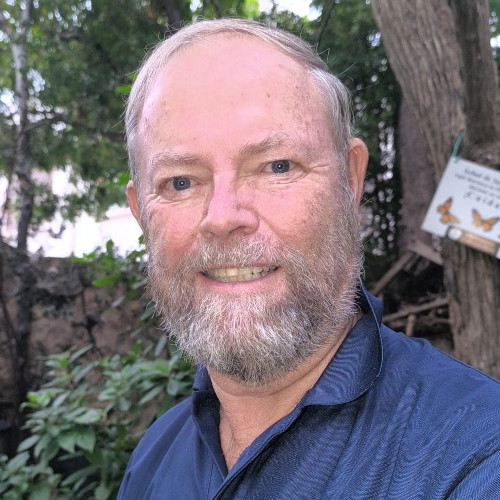Extirpated from the United States a century ago and almost unknown until the mid-1990s, this endangered species can make a comeback if we give it a small boost. New technology for tracking has allowed an assessment and intervention that may help these birds hold on in several critical areas.
Species name:
Thick-billed parrot (Rhynchopsitta pachyrhyncha)
Description:
A typical parrot-green, mid-sized bird weighing 14-17 ounces (400-500 grams) with a distinctive wine-red mask. In flight, a distinctive yellow band is visible under the wings. Their raucous calls sound like laughter in the middle of the forest.

Where They’re Found:
Thick-billed parrots live mostly in Mexico’s Sierra Madre Occidental mountain range. They were presumably once abundant representatives of high-altitude pine forests, where they persist to this day in much smaller numbers due to the destruction of most old-growth forests and the reduction of mature forests. The species is only present in a small number of zones with adequate conditions for nesting, where they’re mostly under protection or good forest management.
IUCN Red List status:
Considered “endangered” in the most recent 2020 assessment, mainly due to habitat loss and an apparent constant decline. The first comprehensive population estimate will be conducted this fall. The parrot will be one of the first bird species to undergo the IUCN’s new Green Status Assessment, which measures the recovery of species populations and their conservation success.
Major Threats:
The extirpation of thick-billed parrots in the northern part of their range is believed to have been caused by hunting or shooting the parrots for “sport” or food. In the Sierra Madre Occidental of Mexico, where the core populations and range have been holding on, massive land-use change — particularly forestry practices to harvest all old-growth and large trees and remove snags that serve as nesting trees — resulted in precipitous decline over the past century, up until very recently. From the 1970s to the 1990s, demand by collectors and the pet trade became an additional threat that has since largely disappeared or represents minimal pressure on the species.
Notable Conservation Programs or Legal Protections:
For 30 years a small group of individuals and institutions have been doing research and developing a suite of techniques for thick-billed parrots, not only for research but also to enhance population growth by mitigating or eliminating factors that increase mortality and reduce productivity.
Most of the work during this time, which provided valuable information and insights, was done at a “pilot scale” and with meager resources. As a result we were basically frustrated witnesses to a species’ decline and potential demise.

Fortunately the species is currently the focus of a comprehensive binational effort of community-based conservation to change the trajectory of decline. The field team is led by Organización Vida Silvestre (OVIS) and supported notably by San Diego Zoo Wildlife Alliance, the Arizona Game and Fish Department, World Parrot Trust, and additional supporters and donors.
Over the next five years (2024-2028) we will implement the full suite of actions, including intensive nest monitoring and management, parasite control on an ad-hoc basis, food supplementation to chicks in select clutches to prevent emaciation, an enhanced nesting box program, fire pre-suppression activities, incentives to local communities, community-based monitoring and nest protection, greater understanding of landscape level need of the thick-billed parrot, and amplifying the telemetry information to include not only long distance movements but also daily activities to food, water and clay licks.
From the first results recorded in 2024, we have renewed optimism that the species can be at least stabilized within a few years and probably begin to recover.
My Favorite Experience:
I had recently finished my Ph.D. when the research and conservation efforts began in the mid-1990s. We negotiated the first-ever “payment to forgo logging rights” in Mexico on what eventually became the Thick-Billed Parrot Sanctuary. The community depended on logging as their main economic activity, and they were not convinced of the utility of forgoing lumber for a small payment to protect a bird. After more than two hours of tense and stalled negotiations, a woman literally stood up to the men who opposed the deal and said, “This is not for us, it is for our children.”
From that moment the negotiations started to move again. Within an hour the deal was sealed for a 15-year moratorium on logging in the core nesting area. Present at the time were a bunch of children running and playing as the negotiations proceeded; one of them was the daughter of the woman who changed the tide.
In 2023 I returned with my former student Miguel Angel Cruz Nieto, who had become principal investigator for the project (and who has sadly since passed away). During our visit we went to a nice, modest house on the way to the parrot sanctuary. Here he reintroduced me to the woman of the negotiation 27 years earlier and to another woman and her two children. The younger woman was at that time the president of the community and had recently signed for another 15 years of forgoing logging. She laughed and said, “You don’t remember me because I was a child when you were here many years ago, but my mother told me how you had led a negotiation that the men opposed until she spoke out.”
What Else Do We Need to Understand or Do to Protect This Species?
The comprehensive population estimate being conducted in fall 2024 will provide a much-needed baseline that has been direly missing. We will continue using our 30 years of data and experience to implement a whole suite of techniques to protect habitat and manage populations in the key nesting areas. We also need to expand our community-based conservation and bring opportunities for education and wellbeing to our allies in the forest-dependent human communities in the parrot’s range. There’s a growing captive flock in zoos around the world, and particularly in the United States, which we view as an insurance population and also serves to educate and sensitize the general public on the plight of the species.
Key Research:
James K. Sheppard et al. Spatial behaviors and seasonal habitat use of the increasingly endangered thick-billed parrot (Rhynchopsitta pachyrhyncha). December 2023. Global Ecology and Conservation 48(e02712):2712
Noel F. Snyder, Ernesto C. Enkerlin-Hoeflich, M. A. Cruz-Nieto, Rene A. Valdes-Peña, Sonia G. Ortiz-Maciel, and Javier Cruz-Nieto. Thick-billed Parrot Rhynchopsitta pachyrhyncha. Birds of the World. Cornell Lab of Ornithology, Version: 1.0 — Published March 4, 2020
Tiberio Monterrubio-Rico and Ernesto Enkerlin-Hoeflich. Present use and characteristics of thick-billed parrot nest sites in northwestern Mexico. J. Field Ornithol. 75(1):96–103, 2004
Dedicated to Miguel Angel Cruz-Nieto (1962-2023), principal investigator in thick-billed parrot research and mature forest conservation 2005-2023.

Previously in The Revelator:
Species Spotlight: Bengal Floricans, Nearing Their Last Dance?


